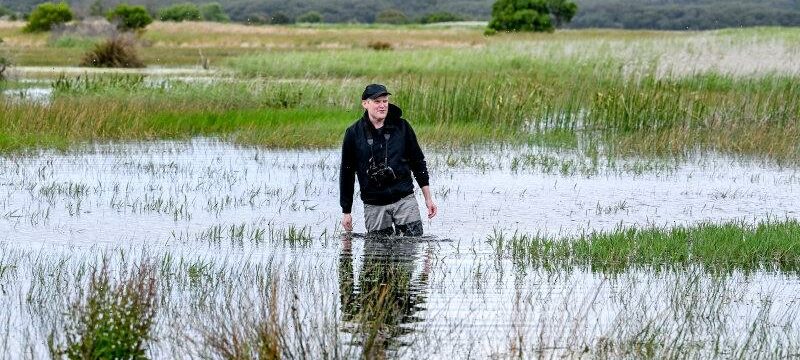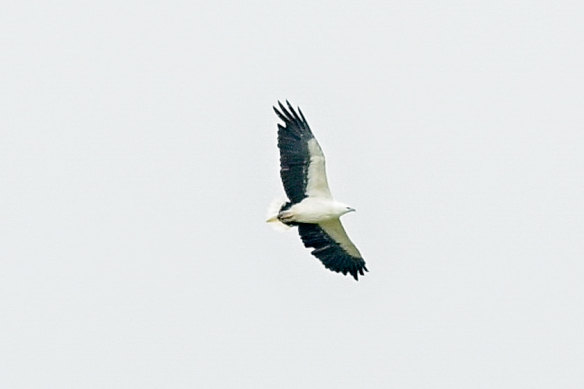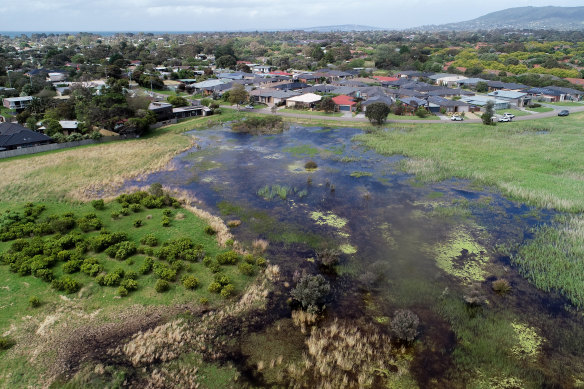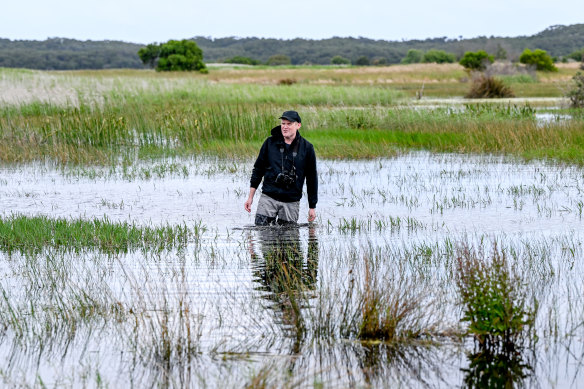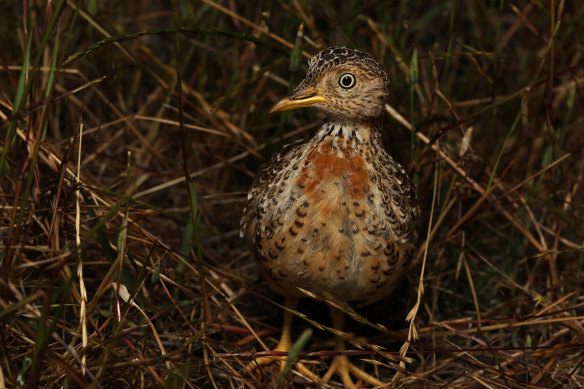Key points
- Months of record-breaking rain have rejuvenated the Tootgarook Wetlands.
- The downpours helped drown out some pest species, including introduced weeds.
- But rain has been a mixed blessing for some species with organic material reducing oxygen levels in the water.
The white-bellied sea eagle has returned to the Tootgarook Wetlands on the Mornington Peninsula, lured by the abundance of prey that have streamed into waterways following months of heavy rain.
The eagle sails the skies, rising above other carnivorous birds – swamp harriers and black-shouldered kites – that cruise closer to the reeds.
A white-bellied sea eagle soars above the Tootgarook Wetlands. Credit:Joe Armao
Ten years ago, this 600-hectare site was mostly grazing land, with native plants downtrodden by the heavy hooves of cattle. Introduced weeds had spread across the landscape.
Now this natural habitat is on the mend, and pest plant species are being drowned out by downpours that have rejuvenated the expansive swamp.
Across south-east Australia, many plants and animal and bird populations declined substantially during the millennium drought and haven’t yet fully recovered. Scientists hope last year’s rains might be their chance.
Much of the Tootgarook Wetlands is privately owned but protected by a Trust for Nature covenant, or legal contract, that prevents development and agriculture.
The non-profit group has been managing the land with the aim of restoring the natural environment.
Trust for Nature south central area manager Ben Cullen said the white-bellied sea eagle hadn’t been seen in the area for many years but was now back, searching for swamp skinks and other reptiles.
“It’s certainly coming around here now and seeing it as a viable bit of habitat,” he said.
Cullen has seen other birds, including the endangered Australasian bittern, also return to the site, where native phragmites (reeds) are expanding in area across the former farmland.
The expanding body of water at the Tootgarook Wetlands.Credit:Joe Armao
“The water has spread out to other areas, which means there’s more habitat,” he said. “There’s more chance of food supplies and hopefully even increasing genetic capabilities because we’re expanding on the viable area that these species can breed in.”
Cullen said the wetland, which is bordered by roads and houses, was crucial in filtering water before it flowed into Port Phillip Bay.
The Bureau of Meteorology has reported Victoria’s spring was the wettest on record. On November 14 alone, Rosebud – a few kilometres away from Tootgarook – received 80.6 millimetres of rain.
The recent floods have caused misery for communities who lost homes and livelihoods in the months-long deluge, from Echuca and Rochester in northern Victoria, which flooded in October, to Mildura, where properties remain under water.
Ben Cullen at the Tootgarook Wetlands. Credit:Joe Armao
At least two people died in floods in Victoria and farmers are counting the cost of widespread destruction of livestock and crops.
Yet, some landscapes naturally adapted to flooding have thrived.
La Trobe University ecologist Professor Andrew Bennett said the La Nina flooding would encourage a system-wide increase in animal populations, particularly those that became isolated and smaller during the drought, like frogs.
An influx of water increases the growth of plants and availability of nectar, and this echoes up the food chain to insects and other invertebrates, birds and animals species.
Not all animals will benefit from heavy rains. Plains-wanderers prefer more open habitat.
“During the drought, animals in the aquatic system like frogs had to contract back to permanent water and were lost in local areas, but with the rivers and streams flowing there might be movement and recolonisation,” Bennett said.
Species like river red gum grow on riverine plains and rely on regular flooding to provide them with water, as does black box in the state’s far north-west.
“The way we manage water, with all the diversions, means the natural flooding regimes have changed and some of these plant species don’t get the flooding they used to,” Bennett said.
But some species may not have benefited from heavy rain. The plains-wanderer, a critically endangered bird that lives in arid grasslands, prefers open, sparse plains, and during periods of strong grass growth their usual habitat might become less suitable.
Under the water, the floods have been a mixed blessing for fish and native crayfish, said Professor Lee Baumgartner, the director of the Gulbali Institute at Charles Sturt University.
The floods will have stimulated a spawning response in many species of fish, and allow larvae and baby fish to grow in the warmer waters.
But parts of the central Murray River, and the Edward River in southern NSW, have been badly affected by blackwater over the past two months, which offsets the fertility benefits upstream.
Blackwater occurs when organic material, like leaves and twigs, are washed off river banks and flood plains and into the river, and bacteria feeding on the decomposing material reduces oxygen in the water. Low dissolved oxygen levels can cause deaths among native fish and aquatic animals.
Murray crayfish had been badly affected by the low oxygen levels in rivers and many have been spotted crawling onto the riverbank, where they dry out and die.
Baumgartner’s institute, in Albury, currently has about 150 crayfish in tanks, as well as native Murray cod, golden perch and silver perch, which were rescued by members of the public.
“Historically, a sizeable flood would have happened every two or three years, but now [because of water management] we see them every 20 years on average, so there’s so much accumulated leaf litter that the bacteria goes crazy,” Baumgartner said.
At many sites along the Yarra River, Melbourne University wetland ecologist Joe Greet said native water ribbons and tuberous plants were overcoming the terrestrial weeds that previously threatened to crowd them out.
“Those weeds are dying back after the floods,” he said. “They’re not adapted to surviving in wetland environments.”
Greet said there was more bird life along the river and frogs were singing with added vigour.
“Just to get out and hear the frogs going bonkers at these sites is a joy,” he said.
Get to the heart of what’s happening with climate change and the environment. Our fortnightly Environment newsletter brings you the news, the issues and the solutions. Sign up here.
Most Viewed in National
From our partners
Source: Read Full Article
